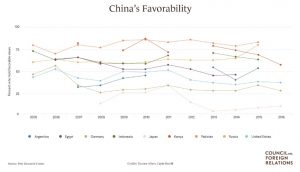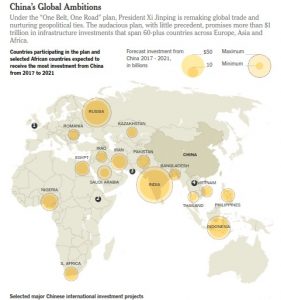China’s One Belt One Road Initiative or “OBOR” is set to draw increased investments, facilitate future trade and position China as an emerging economic power that will rival that of the U.S., experts say.
The program, conceived four years ago, is said to exceed the scope and size of the Marshall plan that was used to rebuild Europe after World War II.
Nearly $1 trillion of projects have been or are in the process of being funded. Construction of ports, tunnels and railways have begun in the region, as well as reclamation of small islands in maritime waters, most controversially those off the South China Sea that are shared with the Philippines and Vietnam.
What OBOR Is and Is Not
As the map above suggests, OBOR is a blueprint that calls for modernizing trading routes and creating supply delivery channels between Eastern and Central Asia, and Eastern and Western Europe.
The program’s key vision is to build new future trading infrastructures – ports, roads, pipes, airports, railways – in the sea and over land, in ways that promote Beijing’s economic and strategic interests.
Six economic corridors are envisioned across sixty countries: one connecting China, Mongolia and Russia; a new Eurasian “Land Bridge”; another from China to Central Asia and Western Asia; a new China-Indochina peninsula corridor; a China-Pakistan economic corridor; and a modern Bangladesh-China-India-Myanmar economic corridor.
At this point in time, it is not, as many have suggested, a free trade agreement. But it is a system for diversifying China’s export markets as it faces anti-globalization headwinds in regions like in the U.S.
It is also a means to address China’s production overcapacity in several sectors in its economy. The overcapacity, owed in past decades to the booms in construction and offshoring manufacturing, is contributing to China’s slowdown.
There is a large amount of capital and exchange reserves in the country as well, and OBOR presents opportunities to diversify investments overseas.
OBOR is not an expansion of China’s military capability, despite characterization already being made in Western media. Still, in order to protect OBOR’s economic interests, China will need to expand the number of its military bases as it has already assertively shown in the South China Sea.

Finally, it is a means to express China’s “soft power,” its advocates say and as Chinese Premiere Xi Jinping suggested in 2014. “We should increase China’s soft power, give a good Chinese narrative, and better communicate China’s message to the world.”
It aims to increase its influence and goodwill in the region and with OBOR partner countries by exporting its approach to development, which has lifted hundreds of millions of its own people and rural farmers out of poverty.
Funding OBOR’s Ambition
Pockets are deep. In 2014, China launched two new financial institutions, the Asian Infrastructure Investment Bank (AIIB) and the Silk Road Fund (SRF), to respond to the substantial financing gap for infrastructure investment in Asia.
AIIB was launched with an initial capital of $84 billion, with China providing $26 billion and other countries supplying the rest – 25 have been recruited in Europe, South America and Africa.
SRF was launched with an initial capital of $33 billion in December 2014. China pledged billions more in additional funding during the summit.
Its Impact – Will OBOR Payoff?
It’s too soon to tell. Already, there are reports of serious protests and of roughshod treatment by the Chinese of indigenous land and of minorities.
It is unclear whether a portion of the billions in funding will be used to address population, environmental and livelihood displacements that are certain to occur. “Farmers are balking at giving up their land. Some are raising questions about property rights.”

In the long run, markets in developing countries along OBOR’s routes will be more diverse. There will be fewer trade barriers and access to investments opportunities will increase, as will exports of Chinese goods and services.
According to the IMF, only seven of the 64 countries in the OBOR initiative are advanced economies. So the potential for growth in the developing and emerging economies, where real GDP is forecast to rise by 6.7% annually over the next 15 years because of OBOR, is high.
Real payoffs won’t occur until after 50 years, acknowledges Wharton emeritus professor Franklin Allen, who also is a professor of finance and economics at Imperial College in London. OBOR’s impact will be significant and “it is quite likely that China will succeed in this initiative, though it may take a half-century,” Professor Allen says.
Sources: Wharton, New York Times, CBBC, Financial Times, The Economist, Reuters








